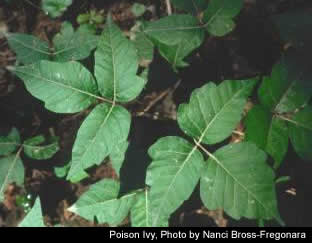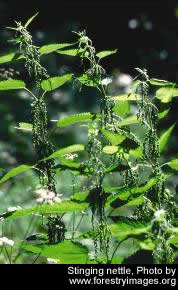

Look, But Don't Touch! Sometimes you have to wonder why some things, such as mosquitoes, ticks and those pesky plants that leave you itching, exist. But being better informed about the state's poisonous flora may help in avoiding that ocean of calamine lotion. In West Virginia, poison ivy is the most prevalent poisonous plant you are likely to encounter. Poison ivy is easily identified by the group of three leaflets that top each stem. It often has white berries in the summer with the leaves turning bright red in the autumn. The thick, climbing vines of poison ivy look like hairy ropes pressed to the bark of a tree. All parts of the poison ivy plant contain the toxic oil urushiol , which can cause skin irritation, especially when the plant has been crushed or broken. Why do plants have these certain chemicals? It all relates to plant survival. A common characteristic in the plant kingdom is the use of chemicals to dissuade herbivores from grazing. Poison ivy rash is seldom more than a nuisance, but serious cases may require medical attention. Remember, too, that toxic oils can be carried in smoke if the plant is burned. The resulting irritation in the lungs can be life threatening. Different people react differently once exposed. The exposure causes an immune response (contact dermatitis) similar to being exposed to a disease-causing organism. Some people will react severely while some have a natural immunity. There are numerous folk remedies for this dermatitis, but one of the most popular ones is jewelweed, also called touch-me-not. This small plant with unusual seed pods that uncoil like springs when touched, is supposed to not only help minimize the rash but also prevent it from forming. However, this treatment may not work for everyone and is more successful with stinging nettle irritation.
Stinging nettle and the related wood nettle are other poisonous plants that are found across the state. Stinging nettles have square stems, tiny green flowers and heart-shaped leaves arranged in opposite pairs along one central stalk that grows one-to three-feet tall along streams and in moist, disturbed habitats. The more common wood nettle has more ovate or egg-shaped leaves and is found in the richly wooded areas of almost every county throughout the state. Nettle leaves are covered with tiny hairs. Each hair is hollow like a hypodermic needle and has a small reservoir of chemical poison at its base. This poison contains a mixture of chemicals including formic acid which is also found in some insects. When a person makes contact with the plant, the tips of the leaf hairs break off, releasing poison into the skin. Contact with a stinging nettle or wood nettle can lead to an itching, burning sensation on the skin that lasts about an hour. Although poison ivy and stinging nettles are sometimes a problem for people, there really is a beneficial side to their existence. Poison ivy berries are a winter food source for many different kinds of songbirds. Young nettle leaves, when properly cooked, can even be eaten by humans as a nutritious side dish. The Mountain State is also home to many other poisonous plants that have an interesting past. Moonseed, a woody, twining vine probably found in every county of the state, has relatives in the jungles of South America where they are used in arrow poisons. West Virginia's moonseed has agents similar to its southern relative and these compounds can relax muscles so much they can cause poisoned animals to fall from trees. Goat's rue contains the chemical rotenone which was placed in streams by Native Americans to bring fish to the surface. It would poison the fish but still leave them edible. Another poisonous plant with a dangerous past is the poison hemlock. Its most famous victim was the Greek philosopher Socrates who was poisoned by a hemlock-laced drink in 399 B.C. The much-branched herb has a smooth, shiny hollow stem covered with purple spots. While all parts of the plant are toxic, the nearly ripe seeds are the most dangerous part of the plant. Often human poisoning arises from mistaking the fruits for anise or from children indiscriminately eating them. In West Virginia, the list of plants containing toxic chemicals, whether in their roots, leaves or berries, numbers more than 200, so the best rule of thumb is to teach children to look, but don't eat or touch! John Beckman, Nanci Bross-Fregonara and Dean Walton contributed to this article. What to Do If You Do Touch... In cases of external contact, the American Red Cross recommends immediately washing the affected area with soap and cold water. It usually takes the chemical urushiol about 15 minutes to cling to the skin. If a rash of weeping sores has already begun to develop, put a paste of baking soda and water on the area several times a day to reduce the discomfort. Lotions, such as Calamine or Caladryl may help soothe the area. Antihistamines, such as Benadryl, may also help dry up the sores (pregnant women should consult their physician). If the condition worsens and affects large areas of the body or the face, see a doctor. If internally consumed, it is best to contact one of the many Poison Control Centers in West Virginia. In addition, the state Department of Agriculture publishes a guide Poisonous Plants, which is free upon request. Call 304-558-3708. An Ounce of Prevention Here are some preventive tips from yourhealth.com and Access Health, Inc. 1. Learn what the poisonous plants look like and avoid any contact with them. |

